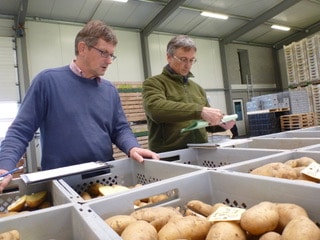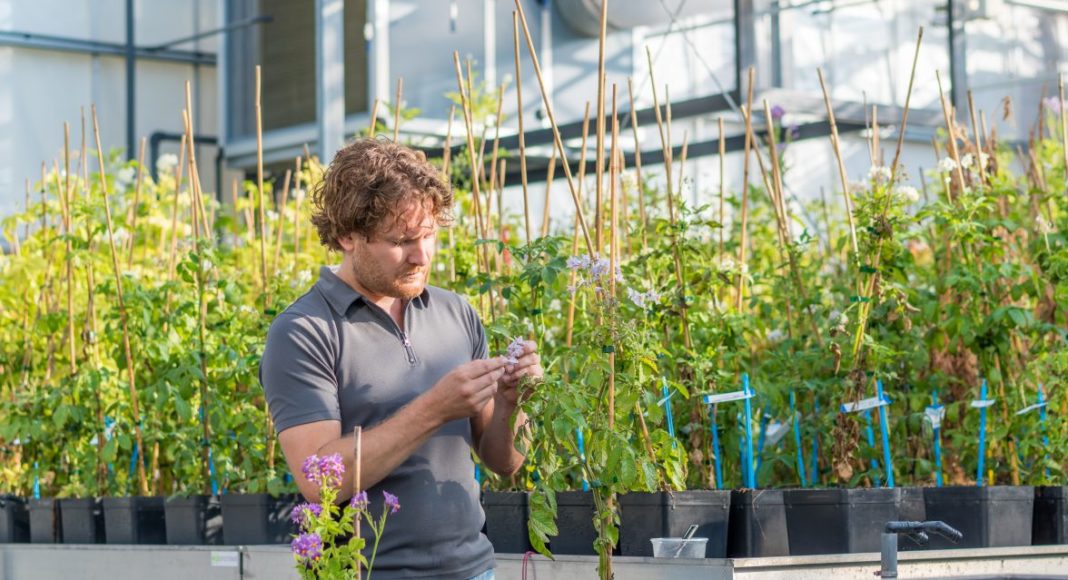[deck]Marcel Bruins, editor of European Seed, discusses the challenges and opportunities of breeding new potato varieties with the leaders of Europe’s major potato breeding companies.[/deck]
Marcel Bruins, editor of European Seed, sat down with the leaders of five major potato breeding companies in Europe to learn more about the challenges of breeding new potato varieties. Piet Smeenge, director of Kweekbedrijf Smeenge-Research; Vanessa Prigge, Crop Improvement project manager at Solana; Gerard Backx, CEO of HZPC; Jan-Paul Bandsma, product manager at de Nijs Potatoes; and Guus Heselmans, R&D manager of C. Meijer B.V., provided insight on this favoured crop.
Breeding for Tolerance to Abiotic Stress
When it comes to breeding for abiotic stress tolerance, Heselmans says C. Meijer B.V. actively selects and breeds for salt, drought and heat tolerance. It can be a challenge to find locations to test these stresses in a reliable and consistent way, he adds. However, there is an even larger obstacle. “A bigger challenge is to find genetic clues on these traits,” he says.
Prigge says Solana is involved in research projects on abiotic stress tolerance, such as drought and salinity, but it doesn’t have special breeding programs for this yet. “Rather, we trial our advanced material under organic growing conditions and diverse climatic conditions where they are subjected to several abiotic stresses naturally occurring in these environments. A certain tolerance to abiotic stress is a must-have for every successful variety.”
Most of the potatoes in the world are grown in Asia and Africa under dry circumstances where abiotic stressors are an important factor, says Backx. “Several abiotic stress items are very important for the varieties for those markets. Stress factors such as drought or heat are important, salt is also important as irrigated areas are becoming more and more salty. Heat is the most important, while water efficiency is important as well,” he says.
Bandsma indicates De Nijs Potatoes is breeding for varieties that are strong in drought, heat and salty conditions. “Heat and drought are not only a problem in the Mediterranean area, Africa, and the other [regions] we are exporting our seeds to. The weather in Europe is becoming more extreme as well. We need potatoes that are strong to heat and drought, or have good tolerance, in combination with an early–medium maturity.”
Improved Nutritional and Health Characteristics
Backx says potatoes are very healthy, in general; however, it is possible to make them even healthier. The HZPC breeding program, he says, works on health characteristics, such as potatoes with a low glycemic index or low caloric French fries, to meet consumer demands.

Prigge says many of Solana’s chip and French fry varieties have low reducing sugar content after cold storage for a longer period, a trait the company specifically focuses on in its breeding program to deliver varieties with reduced acrylamide formation during frying. “This is a complex trait which requires adjustments in both the carbohydrate as well as amino acid metabolisms, which are challenging to improve with classical breeding methods,” she says.
Bandsma says his company also tries to focus on health benefits, but that’s not its first goal. Instead, the company’s main focus is selling seed potatoes for export. “We are spreading our opportunities, so for our small table potato segment, we try to focus on it.”
Additional Breeding Targets
For the processing industry, it is important to understand the clients’ requirements. Customers partly determine the variety that needs to be processed for them, and colour and length are important items.
“We focus mainly on low sugar content, good quality for French fries and crisps, and red varieties for the ‘red market,’ in addition to a nice skin finish for pre-packing, and no greening of the tubers in daylight,” says Smeenge.
Backx states that for table varieties, shape is important. The variety needs to have a smooth skin (no deep eyes), so they can be peeled easily, or when boiled with the skin on, the potatoes look appetizing.
For Heselmans, a variety should have added value for the potato chain, starting with the consumer. “The target is to combine traits in such a way that the sum of traits results in an improved variety, whereas no single trait will be below a minimum level.”
Prigge believes quality is a major breeding goal in potato, but again the specific requirement depends on the market segment.
“There is currently high demand for reducing acrylamide levels in fried potato products due to official recommendations following a recent risk analysis of the European Food Safety Authority. That means it may not be sufficient to score processing varieties purely visually for their frying colour, which is the current method of choice, but actual acrylamide levels may need to be measured. This would require sophisticated equipment and be costlier.”
Access to Germplasm
According to Backx, HZPC works on its genepool to create parent plants. “Commercial varieties, but especially material from genebanks, is used. We also go back to material originating from the Andes and support the custodian farmers in the Andes to maintain the enormous collection of old potato varieties.”
Smeenge says the main source of diversity in his breeding program are his own bred varieties (more than 20) and seedlings. He also uses varieties/seedlings from colleague breeders or potato companies. Meanwhile, Heselmans says C. Meijer B.V. uses varieties from colleague breeders from all over the world and makes use of new genetic sources.
Due to the extremely high number of selection traits in potato, says Prigge, the choice of crossing parents is never of the type “best-by-best,” but is always a compromise.
“For specific traits that are not available in the variety pool, we are lucky to have a vast collection of wild and unadapted potato relatives in public gene banks and we make use of these in introgression breeding programs. The challenge is to get rid of the undesired characteristics of these wild species that come as linkage drag during introgression, such as late maturity, long stolons, deep eyes, low yield, poor tuber shapes, and so on,” she says.
There are thousands of accessions available from gene banks, continues Prigge. She says with this genetic diversity at hand and with a tetraploid crop, if anything, they need to find resources to better characterize the available germplasm to make better use of it in breeding and to find ways of fixing desirable allele combinations.
Prigge also comments on access to genetic materials and benefit sharing. “Also, except for Solanum phureja, potato is listed in Annex 1 of the International Treaty for Plant Genetic Resources in Food and Agriculture and, hence, the Nagoya protocol does not apply. We are fully supportive of the ITPGRFA and the ongoing process to enhance the functioning of the multilateral system of access and benefit sharing.”
Until now, Heselmans says his company has not had difficulty with new regulations; however, he does anticipate more bureaucracy in the future when new material is taken into his program.
“We believe that breeders and PVP [plant variety protection] legislation by itself already play an important role with [genetic] benefit sharing, by releasing varieties and having these varieties freely used by other breeders for crossing. Breeders exemption enhances innovation.”
Bandsma is of the opinion that his company has sufficient access to new germplasm because FOBEK, De Nijs’ breeding company, is responsible for its breeding program. Smeenge also feels there is enough access to new germplasm. However, Backx does not agree.
“Those regulations make it more cumbersome to get material and may be very expensive. We are not against the principle. But we should not block plant breeding and variety improvement.”
Editor’s Note: To read “Potato Breeding: A European Approach, Part I,” visit spudsmart.com. Part III will be available in Spud Smart’s Summer 2019 issue and will examine where European breeding companies are focusing their development investments, and future products and innovations in the pipeline.











